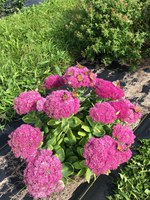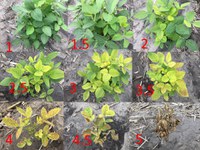Dakota Gardener: Fall Flowers Nourish the Bees and Butterflies
(Click an image below to view a high-resolution image that can be downloaded)
By Esther McGinnis, Horticulturist
NDSU Extension
Planting late-summer and fall-blooming perennials can seal your reputation as an exceptional gardener.
When everyone else’s garden is looking tired in September, your garden can be the showcase of the entire neighborhood with a fresh set of blooms.
Besides their ornamental appeal, late-season blooms play an important role in sustaining native bee and butterfly populations.
Late summer is when male bumblebees and next year’s queens are hatched. The male bumblebees perpetuate the species by mating with the new queens. The pregnant queen then feeds heavily on nectar and pollen to fatten up for winter while the rest of the colony dies in the fall. Only the new queen overwinters in an underground burrow and produces offspring the following year to form a new colony.
Likewise, fall flowers are important for butterflies. Painted lady butterflies are frequently observed on fall flowers.
However, the monarchs are the true stars of the garden in the fall. They need to find nectar-rich flowers to feed the beginning generations that start the long migration to winter grounds in Mexico.
North Dakota State University has studied late-season native and ornamental perennials for their ability to attract and nourish bees and butterflies. In the study, Extension entomologists counted the number of bees, butterflies and beneficial insects that landed on the flowers to determine the best pollinator plants for home landscapes.
Ornamental tall sedums that bloom in August and September are surprisingly good pollinator plants. These drought-tolerant succulents attract a surprising range of bees and butterflies. The cultivars ‘Autumn Fire’ and ‘Autumn Joy’ are two of the best for attracting a wide range of pollinators.
The more compact cultivar, ‘Neon,’ produces pretty pink blooms that seem to attract butterflies. Every time I approached ‘Neon,’ a cloud of painted lady butterflies would take flight.
Asters are one of the last plants to bloom in the ornamental landscape and are underutilized. They bloom from late August until the first heavy frost.
Selecting an aster can be tricky for a couple of reasons. First, some of the native asters are too large for a managed landscape. Other asters may bloom too late in the season and may experience a heavy frost before reaching full bloom. The cultivars ‘Purple Dome’ and ‘Raydon’s Favorite’ do not reach their full potential in the northern Great Plains because of their late bloom.
Recommended aster cultivars include ‘Alma Potschke’ and ‘Dream of Beauty.’ ‘Alma Potschke’ produces magenta flowers in early fall and is a butterfly magnet. However, the plant may need to be staked to keep it upright.
‘Dream of Beauty,’ with its compact habit, fits better in smaller landscapes. Its pink blooms are a welcome addition to the fall garden. This cultivar attracts fewer pollinators than ‘Alma Potschke.’
For more information, see the NDSU Extension publication “Pollinator Preferences for Selected Aster, False Indigo, Bee Balm and Sedum Flowers in North Dakota” at https://www.ag.ndsu.edu/publications/lawns-gardens-trees/pollinator-preferences.
For more information about gardening, contact your local NDSU Extension agent. Find the Extension office for your county at https://www.ag.ndsu.edu/extension/directory/counties.
NDSU Agriculture Communication - Aug. 17, 2021
Source: Esther McGinnis, 701-231-7971, esther.mcginnis@ndsu.edu
Editor: Ellen Crawford, 701-231-5391, ellen.crawford@ndsu.edu





